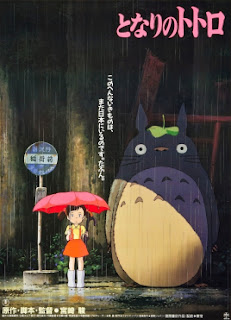Filmmaker Hayao Miyazaki
has often been referred to as the Walt Disney of Japan. I would argue in some
cases he is even better than the man who created Mickey Mouse. The animation in
his movies are stunning, the characters are humans who deal with real-life emotions
and pains, and his stories have mostly no villains. His 1988 classic My
Neighbor Totoro checks all those boxes and introduced the world to Miyazaki’s
own Mickey Mouse even if this creature is limited to only saying his own name.
Think of it as a Pokémon minus the annoyance.
It’s hard to keep
track, but I believe the last time I was in theatres to see a movie was in
early March. Since then it’s been deep dives into movies I own and everything
available on streaming services. This year Netflix got its hands-on Miyazaki’s
Studio Ghibli movies, which gave me a chance to check My Neighbor Totoro off
my watch list. It will probably be a few more weeks at least before we can all
go back to theatres, so I highly recommend Totoro and everything else Miyazaki
has done in the meantime.
The story is very
accessible since there is not much of a traditional plot in the sense of
characters going from point A to point B. A father and his two daughters move
to a small house in the Japanese countryside to be closer to his wife who is
being treated at a local hospital for an unnamed illness. The daughters, older
Satsuki sister and younger sister Mei, are loving the house even though it is old
and rickety. These are not spoiled kids. They love it even more when they find
thousands of tiny black dust-like creatures that the kindly old neighbor claims
are spirits.
The voice of these
characters of course depends on your viewing options. Viewers have the option
of listening to the original Japanese cast and read subtitles in the language
of their choice or listen to dubbed version. I dabbled between choices early on
and was surprised to recognize the voice of actor Tim Daly, best-known as the
voice of Superman, voicing the father character. As for the two sisters, they
are voiced by the Fanning sisters, which makes perfect sense.
The black dots the girls
see are completely harmless and are not the only magical things living in the
area. When Mei goes exploring in the woods, she finds a huge tree that hides a
hole. Falling through the hole she lands on a creature so big it could eat her
in one bite, but so fluffy he is the perfect landing mat. The creature’s name
is Totoro, which Mei gathers since it is the only sound it emits, always in loud
growls: TO-TO-RO!!
It would be scary if it
wasn’t for the fact Totoro is essentially a giant cat. It is covered in fur, has
two pointy ears, a big belly, and a small nose with whiskers. Plus, the big
fellow loves to nap and play. Cat owners will recognize a lot in this creature.
One of the movie’s most
iconic sequence is when Mei and Satsuki are waiting for their father at a bus
stop in the woods during a rainstorm. The two girls have their umbrella deployed
and wouldn’t you know it, suddenly Totoro is casually standing next to them. Since
Totoro is no regular commuter he is not waiting for a regular bus. His
transportation is the Catbus, another iconic Miyazaki creation. That creature
has 12 legs, glowing eyes, a long bushy tail, a roof and windows on its back,
and is of course the size of a bus. What a feat of imagination.
Adults might wonder if
Totoro and his fellow magical creatures are real or if this is all taking place
in the girls’ minds. For one thing no adults ever see Totoro and when the
father goes looking for his home, the hole has somehow disappeared. The fact is
it doesn’t really matter. Totoro is real enough for the girls and he is the
friend they need at this time in their lives.
If you remove the
magical elements, this a story about children facing a tough situation. Any day
they might get bad news about their mother’s health and their father might not
be there for them since he is busy with work. Young Mei is not yet equipped to deal
with this, and Satsuki doesn’t always have the patience to deal with her. The
movie portrays these characters realistically, but things never go too dark.
My Neighbor Totoro
must be a joy for young
children, but adults can easily enjoy it too because of the imagination at work
and the gorgeous animation. Like its titular character it is a very fluffy
movie, which we could all use right now.

Comments
Post a Comment